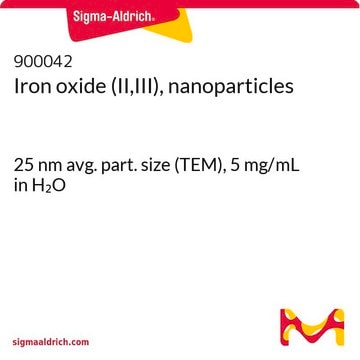720704
Iron(III) oxide, dispersion
nanoparticles, ≤110 nm particle size, 20 wt. % in H2O
Synonym(s):
Iron oxide in water
Sign Into View Organizational & Contract Pricing
All Photos(1)
About This Item
Empirical Formula (Hill Notation):
Fe2O3
CAS Number:
Molecular Weight:
159.69
MDL number:
UNSPSC Code:
12352300
PubChem Substance ID:
NACRES:
NA.23
Recommended Products
form
nanoparticles
concentration
20 wt. % in H2O
particle size
≤110 nm
pH
6-8
density
1.17 g/mL±0.1 g/mL at 25 °C
SMILES string
O=[Fe]O[Fe]=O
InChI
1S/2Fe.3O
InChI key
JEIPFZHSYJVQDO-UHFFFAOYSA-N
Looking for similar products? Visit Product Comparison Guide
Storage Class
10 - Combustible liquids
wgk_germany
nwg
flash_point_f
Not applicable
flash_point_c
Not applicable
Certificates of Analysis (COA)
Search for Certificates of Analysis (COA) by entering the products Lot/Batch Number. Lot and Batch Numbers can be found on a product’s label following the words ‘Lot’ or ‘Batch’.
Already Own This Product?
Find documentation for the products that you have recently purchased in the Document Library.
Customers Also Viewed
Magnetic iron oxide nanoparticles: synthesis, stabilization, vectorization, physicochemical characterizations, and biological applications
Laurent S, et al.
Chemical Reviews, 108(6), 2064-2110 (2008)
Brian T Farrell et al.
Neurology, 81(3), 256-263 (2013-06-19)
The study goal was to assess the benefits and potential limitations in the use of ultrasmall superparamagnetic iron oxide (USPIO) nanoparticles in the MRI diagnosis of CNS inflammatory diseases and primary CNS lymphoma. Twenty patients with presumptive or known CNS
J Sangeetha et al.
Journal of biomedical nanotechnology, 9(5), 751-764 (2013-06-28)
We present methodologies to functionalize iron oxide (Fe3O4) nanoparticles with biosurfactants and biocompatibility results. Positively charged Fe3O4 nanoparticles of average hydrodynamic size -26 nm is functionalized with four different molecules of interest, viz., surfactin, rhamnolipid, polyethylene glycol (PEG) and dextran.
Alice Panariti et al.
Journal of biomedical nanotechnology, 9(9), 1556-1569 (2013-08-29)
Magnetic nanoparticles have emerged as important players in current research in modern medicine since they can be used in medicine for diagnosis and/or therapeutic treatment of diseases. Among many therapeutic applications of iron-based nanoparticles, drug delivery and photothermal therapy are
Andrew Pratt et al.
Nature materials, 13(1), 26-30 (2013-11-05)
Geometry and confinement effects at the nanoscale can result in substantial modifications to a material's properties with significant consequences in terms of chemical reactivity, biocompatibility and toxicity. Although benefiting applications across a diverse array of environmental and technological settings, the
Our team of scientists has experience in all areas of research including Life Science, Material Science, Chemical Synthesis, Chromatography, Analytical and many others.
Contact Technical Service



